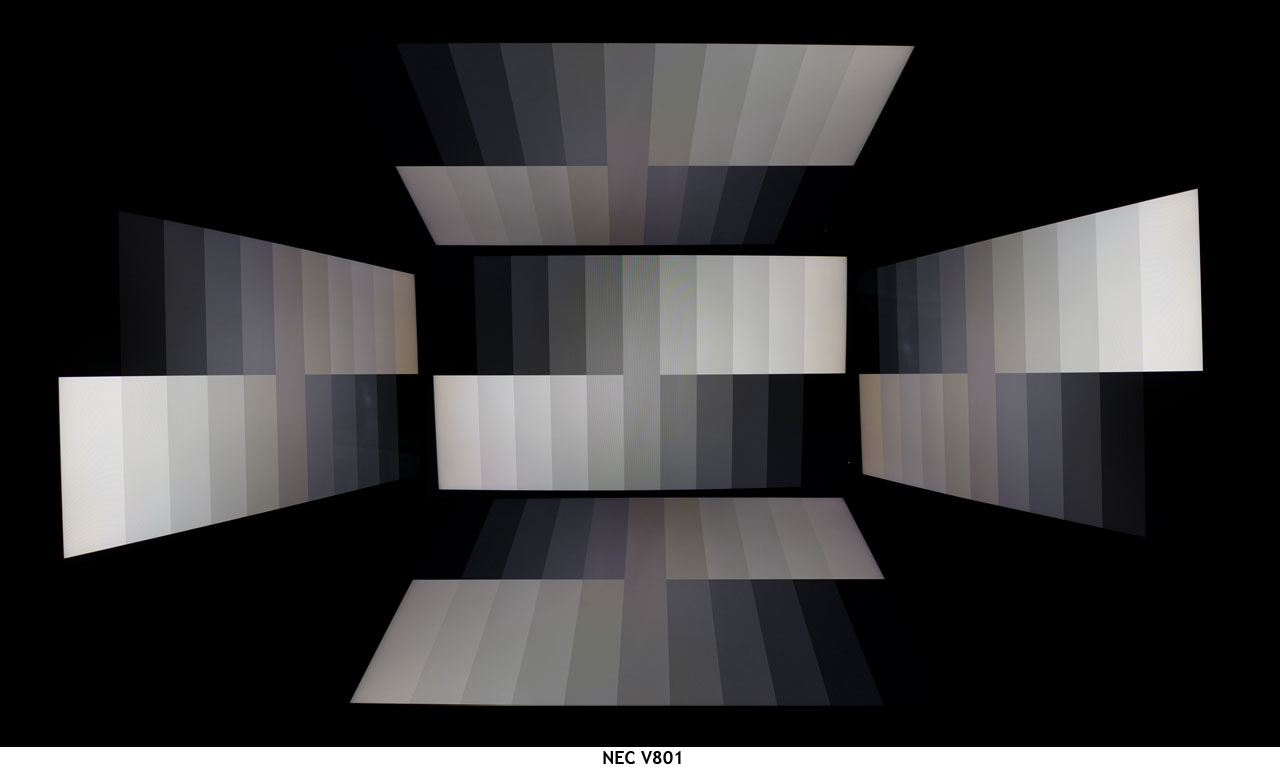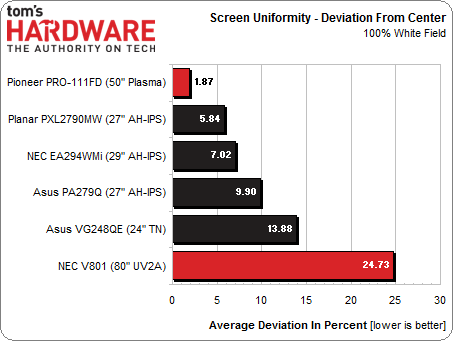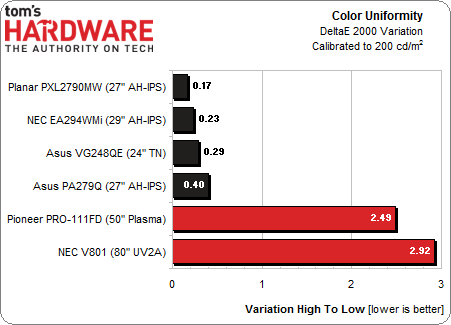NEC V801 Review: Benchmarking A Massive 80-Inch Monitor
Results: Viewing Angle And Uniformity
Viewing angles are extremely important for a panel this large. In a home theater environment, you’ll likely be sitting 10-12 feet away, which means the angle from the center seat to the sides of the screen is around 32 degrees. We shoot our photos at a 45 degree angle, which, in the case of the V801, correlates to a seven-foot seating distance. That's definitely too close because you’ll see the pixel structure.
If you expand the photo, you can see there are slight color shifts in both the horizontal and vertical offsets. Light falloff is almost imperceptible, which is better than what we’re used to seeing from IPS screens. In normal content the color shift is barely noticeable. This is one of the best LCD panels we’ve ever seen with regards to off-axis image quality. And it’s another reason why the V801 is so well suited to be a home theater screen as well as a presentation monitor. We’re also impressed with how well shadow detail holds up as you move off-center. You can easily enjoy this display with a few friends and no one will fight for the middle seat.
Screen Uniformity: Luminance
To measure screen uniformity, we use zero percent and 100 percent full-field patterns, and sample nine points. In a change from previous reviews, we’re now comparing the results to other monitors we’ve measured. First, we establish a baseline measurement at the center of each screen. Then the surrounding eight points are measured and their values expressed as a percentage of the baseline, either above or below. We average this number. It is important to remember that we only test the review sample each vendor submits. Other examples of the same monitor can measure differently in this metric.
First up is black field uniformity.
This is where a large-format display is at a disadvantage to desktop-sized screens. A monitor of this size is bound to have hotspots. The center of the V801 is just a bit brighter than the surrounding areas. Considering that it’s an edge-lit display, we're still very much impressed.
We're surprised that the Pioneer plasma doesn't exhibit better uniformity in a black field. At least it's dark enough to hide the the hotspots. Only the meter knows the true result.
Here’s the white field measurement.
Get Tom's Hardware's best news and in-depth reviews, straight to your inbox.
The V801 is brighter at the center in the white field measurement as well. Again, it’s barely noticeable to the eye given the sheer size of the screen. But its deviation is higher than the desktop monitors we’ve tested. The Pioneer, on the other hand, rockets to the top of the pack.
Screen Uniformity: Color
To measure color uniformity, we display an 80 percent white field and measure the Delta E error of the same nine points. Then we simply subtract the lowest value from the highest to arrive at the result. A smaller number means a display is more uniform. Any value below three means that variation is invisible to the naked eye.
We have yet to measure any monitor that has visible color shift across an 80 percent white field pattern. Both the V801 and the PRO-111FD are under the threshold. Again, this is a very difficult test for such large a panel.
Current page: Results: Viewing Angle And Uniformity
Prev Page Results: Color Gamut And Performance Next Page Results: Pixel Response And Input Lag
Christian Eberle is a Contributing Editor for Tom's Hardware US. He's a veteran reviewer of A/V equipment, specializing in monitors. Christian began his obsession with tech when he built his first PC in 1991, a 286 running DOS 3.0 at a blazing 12MHz. In 2006, he undertook training from the Imaging Science Foundation in video calibration and testing and thus started a passion for precise imaging that persists to this day. He is also a professional musician with a degree from the New England Conservatory as a classical bassoonist which he used to good effect as a performer with the West Point Army Band from 1987 to 2013. He enjoys watching movies and listening to high-end audio in his custom-built home theater and can be seen riding trails near his home on a race-ready ICE VTX recumbent trike. Christian enjoys the endless summer in Florida where he lives with his wife and Chihuahua and plays with orchestras around the state.
-
Someone Somewhere Yeah, 1920x1080... those pixels are 0.92mm square. That's pretty easy to see with the naked eye; far bigger than a full stop.Reply
27.5ppi... *shudders*.
EDIT:
the V801’s size is better expressed in feet: 227.6 (69.37 square meters for the rest of the world)
Ummm... 70 square meters is pretty big. That's about half of the average house. I think you'll find it's ~1.76 m² or 19 ft². -
virtualban For that size I clicked the article in hopes that maybe it was some 8K monitor. Stopped reading after 1080pReply -
baddad I've had a Mits 82" DLP since 2011 I paid $1900.00, that is the heart of my media center, so $9400 for just a monitor is a bit much.Reply



